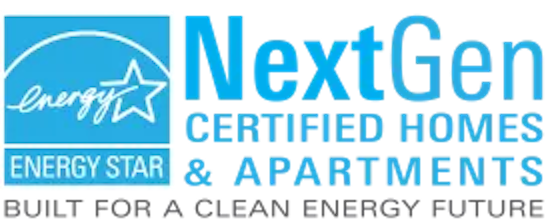EnergyStar has been the leading proponent of the energy-efficiency movement in the US over the last several decades.
While many people are familiar with EnergyStar’s sticker on many high-end electric appliances, in recent years, EnergyStar has channeled its focus into curbing greenhouse gasses from the construction sector.
One of its newest programs is the EnergyStar NextGen™ initiative. It collaborates with home builders to create more energy-efficient homes using ultra-efficient home upgrades, such as electric heat pumps and charging stations.
This article will explore the new technologies builders can incorporate with the NextGen™ program to reduce emissions and acquire tax credits.
What Is NextGen™ from EnergyStar?
NextGen™ is a mutual collaboration between builders and EnergyStar to implement the newest energy-efficiency upgrades into new homes and apartments. According to EnergyStar, NextGen™-certified homes are at least 20% more energy-efficiency than homes built to meet similar building codes.
The program, funded by the Inflation Reduction Act, aims to educate users on the benefits of this technology, which range from reduced energy use to lower carbon dioxide levels and greater home comfort.
Like its previous EnergyStar Home Certification, the program does not offer direct benefits, but it qualifies most builders to achieve the 45L tax credit, among other rebates.
Some of the new energy-efficiency upgrades included in NextGen™ include:
- Multi-speed EnergyStar electric heat pumps
- EnergyStar connected electric water heaters
- Electric cooktops and ranges
- Level 2 EV charging stations (in homes with private parking)
How Builders Can Benefit from NextGen
Builders who implement many of the upgrades from the NextGen™ initiative can qualify for EnergyStar home certification and the 45L tax credit. Builders who abide by the highest tiers of the EnergyStar home program or DOE Zero Energy Ready Home (ZERH) program requirements can receive a $5,000 credit for a single-family home, offsetting most of the cost of these upgrades.
Likewise, NextGen™ also provides excellent marketing materials for builders to reach more customers and list new homes at higher prices. Customers benefit by paying less in utilities, while builders can leverage these program requirements for higher profits.
5 Tips to Become EnergyStar Certified
EnergyStar certification for homes is rigorous, but with the right help, acquiring certification can be straightforward.
1. Follow EnergyStar 3.1 Guidelines
First, brush up on the latest EnergyStar guidelines, which the agency releases every few years. EnergyStar 3.1 outlines several efficiency requirements for major home components, including HVAC, ventilation, insulation, and lighting systems. We’ve created a guide on EnergyStar 3.1 guidelines to help builders understand what is required and what resources they can consult to meet these requirements.
2. Work with an Energy Rater
One resource readily available to builders to help them meet EnergyStar guidelines is a certified home rater. While required to reach a specific Home Energy Rating Score (HERS), the energy rater can provide tips and solutions to help you improve your HERS score.
3. Electrify
In recent years, EnergyStar has narrowed its recommendations to strictly electric appliances, including heating systems, cooktops, and more. Investing in high-efficiency electrical systems can reduce your home’s emissions and lower energy consumption to meet EnergyStar requirements.
4. Look for EnergyStar Labels
One quick and easy win for builders is installing brand-new EnergyStar-labeled appliances, which the agency tests and backs for efficiency. On average, EnergyStar appliances are required to be anywhere from 15% to 50% more efficient than federal standards, depending on the appliance.
5. Follow NextGen™ Recommendations
EnergyStar’s NextGen™ program outlines several upgrades to help homes reduce their energy consumption and greenhouse gasses by up to 20%. By implementing new heat pumps and charging stations outlined under the NextGen™ program, new homes can become NextGen™-certified and market this to potential buyers.
FAQs
Is there financial assistance available for building ENERGY STAR NextGen™ homes?
Various incentives, rebates, and grants, such as the 45L tax credit, may be available at federal, state, and local levels to support the construction of ENERGY STAR NextGen™ homes. Builders and homeowners should check with local utility companies, government programs, and the ENERGY STAR website for information on available financial assistance.
Where can I find more information about ENERGY STAR NextGen™?
For more detailed information, visit the official ENERGY STAR website or our blog. For the latest EnergyStar guidelines, you can also contact local certified Home Energy Raters and ENERGY STAR partners for guidance and support.

